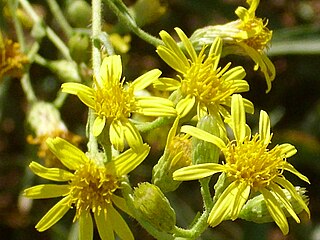
The Scrophulariaceae are a family of flowering plants, commonly known as the figwort family. The plants are annual and perennial herbs, as well as shrubs. Flowers have bilateral (zygomorphic) or rarely radial (actinomorphic) symmetry. The Scrophulariaceae have a cosmopolitan distribution, with the majority found in temperate areas, including tropical mountains. The family name is based on the name of the included genus Scrophularia L.
Saponins are bitter-tasting usually toxic plant-derived secondary metabolites, being organic chemicals, that have a foamy quality when agitated in water and a high molecular weight. They are present in a wide range of plant species throughout the bark, leaves, stems, roots and flowers but found particularly in soapwort, a flowering plant, the soapbark tree, common corn-cockle, baby’s breath and soybeans. They are used in soaps, medicines, fire extinguishers, as dietary supplements, for synthesis of steroids, and in carbonated beverages. Saponins are both water and fat soluble, which gives them their useful soap properties. Some examples of these chemicals are glycyrrhizin and quillaia, a bark extract used in beverages.

Turnera diffusa, known as damiana, is a shrub native to southern Texas in the United States, Mexico, Central America, South America, and the Caribbean. It belongs to the family Passifloraceae.

Blanford's fox is a small fox native to West Asia and Central Asia. It is listed as Least Concern on the IUCN Red List.

Calotropis is a genus of flowering plants in the family Apocynaceae, first described as a genus in 1810. It is native to southern Asia and North Africa.

Calendula officinalis, the pot marigold, common marigold, ruddles, Mary's gold or Scotch marigold, is a flowering plant in the daisy family Asteraceae. It is probably native to southern Europe, though its long history of cultivation makes its precise origin unknown. It is also widely naturalised farther north in Europe and elsewhere in warm temperate regions of the world.

Aporphine is an alkaloid with the chemical formula C17H17N. It is the core chemical substructure of the aporphine alkaloids, a subclass of quinoline alkaloids. It can exist in either of two enantiomeric forms, (R)-aporphine and (S)-aporphine.

Swertia is a genus in the gentian family containing plants sometimes referred to as the felworts. Some species bear very showy purple and blue flowers. Many members of this genus have medicinal and cultural purposes.

A depside is a type of polyphenolic compound composed of two or more monocyclic aromatic units linked by an ester group. Depsides are most often found in lichens, but have also been isolated from higher plants, including species of the Ericaceae, Lamiaceae, Papaveraceae and Myrtaceae.

Fabiana is a genus of flowering plants in the nightshade family, native to dry slopes in western South America. They are evergreen shrubs or subshrubs, with needle-like leaves and profuse tiny tubular flowers in summer. The common name is false heath because the leaves superficially resemble those of the distantly related heaths. The species F. imbricata is cultivated as a common horticultural plant and a common herbarium specimen.

Inuleae is a tribe of flowering plants in the subfamily Asteroideae.

Chiliadenus is a genus of flowering plants in the family Asteraceae.

Bakuchiol is a meroterpenoid in the class terpenophenol.

Gelsemine (C20H22N2O2) is an indole alkaloid isolated from flowering plants of the genus Gelsemium, a plant native to the subtropical and tropical Americas, and southeast Asia, and is a highly toxic compound that acts as a paralytic, exposure to which can result in death. It has generally potent activity as an agonist of the mammalian glycine receptor, the activation of which leads to an inhibitory postsynaptic potential in neurons following chloride ion influx, and systemically, to muscle relaxation of varying intensity and deleterious effect. Despite its danger and toxicity, recent pharmacological research has suggested that the biological activities of this compound may offer opportunities for developing treatments related to xenobiotic or diet-induced oxidative stress, and of anxiety and other conditions, with ongoing research including attempts to identify safer derivatives and analogs to make use of gelsemine's beneficial effects.

Gigactonine is a naturally occurring diterpene alkaloid first isolated from Aconitum gigas. It occurs widely in the Ranunculaceae plant family. The polycyclic ring system of this chemical compound contains nineteen carbon atoms and one nitrogen atom, which is the same as in aconitine and this is reflected in its preferred IUPAC name.

Filipendula glaberrima, also called Korean meadowsweet, is a species of plant in the family Rosaceae that is native to Korea. The genus Filipendula is classified as a perennial herbaceous ornamental plant of the botanical family Rosaceae. The historical utilization of Filipendula plants in traditional medicine can be attributed to their diuretic, antiseptic, anti-rheumatic, stomachic, and antacid qualities. Plants belonging to the genus Filipendula have various beneficial properties, including antioxidant capacity, anticancer activity, anti-inflammatory effects, anti-colitis properties, anti-hyperalgesic properties, antigenotoxic effects, hepatoprotective activities, and skin-moisturizing properties.

Hypericum ericoides is a dwarf shrub in the flowering plant family Hypericaceae, section Coridium. It is found in eastern and southeastern Spain, Morocco, and Tunisia. Its preferred habitat is fissures in calcareous rocks in warm, sunny places, from 200 to 2,000 meters above sea level (MASL).

Alchemilla diademata, also known as the diadem lady's mantle, is a species of the genus Alchemilla endemic to Lebanon. The plant has been commonly used in folk medicine in Lebanon and its promising bioactive properties have been subject to a number of studies.

Klasea pusilla, is a species of flowering plant in the genus Klasea within the family Asteraceae. It is a native of the Eastern Mediterranean region.


















